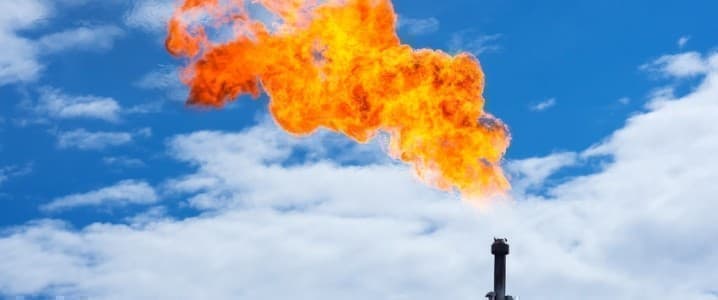A state environmental agency in Kazakhstan has fined an oil company in the west of the country $780,000 over a prolonged fire at one of its fields last year that caused one of the largest emissions of methane in history.
The ecology department of the Mangystau regional government said on February 19 that methane concentrations at the Buzachi Neft-operated Karaturun field exceeded permissible levels by 480 times.
The alarm over the leak was raised by geo-monitoring firm Kayrros SAS, which reported in July that it had produced satellite imagery showing clouds of methane rising from the oil field.
Buzachi Neft told Bloomberg news agency at the time that the “satellite images likely [showed] hot vapor clouds with minimal traces of the greenhouse gas.”
That explanation was dismissed by Kayrros.
“It is extremely unlikely to mistake water vapor for methane on multiple images captured by two hyperspectral satellites, whose very high spectral resolution leaves little doubt about the nature of the gas observed,” Kayrros told Bloomberg. Related: EU Carbon Prices Tumble to More Than Two-Year Low
Buzachi Neft elsewhere sought to claim that it was taking measures to mitigate methane emissions.
“In order to avoid the unauthorized release of gasses in the area of well No. 303, the company regularly fires a burning charge into the clouds evaporating from the zone of active combustion,” Daniyar Duisembayev, deputy general director for strategic development at Buzachi Neft, told Vlast news website in a written statement in August.
This was in turn contradicted by researchers with the SRON Netherlands Institute for Space Research and the Valencia Polytechnic University.
“The relatively low intensity of the fire at the Karaturun East site would indicate that only a small fraction of the gas outflow was flared,” the researchers said in a paper published last week.
Such large emissions of methane are alarming because the gas has a far more potent greenhouse effect than carbon dioxide.
The fire that triggered the leak broke out at an oil well at the Karaturun field on June 9. The blaze was only put out on December 25.
The Mangystau region ecology department said it initiated an unscheduled inspection of the offending site in January — one month after the blaze was extinguished and six months after the issue was reported by both domestic and international media.
News of the fine, meanwhile, comes just days after the BBC published its own report on the methane leak. The BBC’s report cited the U.S. Environmental Protection Agency's Greenhouse Gas Equivalency Calculator as assessing that the leak was “comparable to that of driving more than 717,000 petrol cars for a year.”
The Mangystau ecology department inspection revealed, among other things, that drilling on the well that exploded had been, under the terms of the development license, due to begin in 2024, but that it began in May 2023 instead.
“Based on the results of the inspection, the company was ordered to develop a remediation program to eliminate the environmental damage caused,” the department said.
These developments have only consolidated Central Asia’s dismal reputation as a major contributor to the greenhouse gas crisis.
The Guardian newspaper reported in 2023, citing satellite data, again provided by Kayrros, on how methane leaks at two gas fields alone in Turkmenistan in 2022 contributed more to global warming than did all the United Kingdom’s carbon emissions.
In attempt to repair that public relations damage, Turkmenistan announced at the COP-28 climate summit in Dubai that it would sign up to the Global Methane Pledge, a voluntary agreement that commits adherents to cut methane emissions by 30 percent by 2030.
In doing so, it joined another new adherent to the Global Methane Pledge: Kazakhstan.
More Top Reads From Oilprice.com:
- Rystad: Energy Transition Requires $3.1 Trillion in Grid Investment by 2030
- Can Hydrogen Cars Compete With EVs?
- Iron Ore Prices Rise as China Ramps Up Imports


















